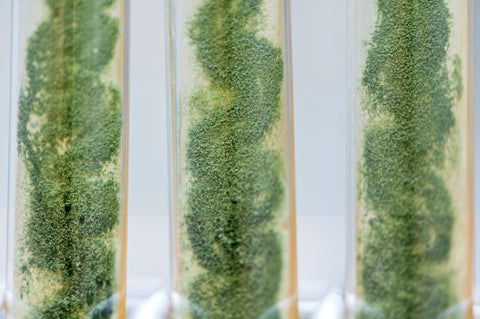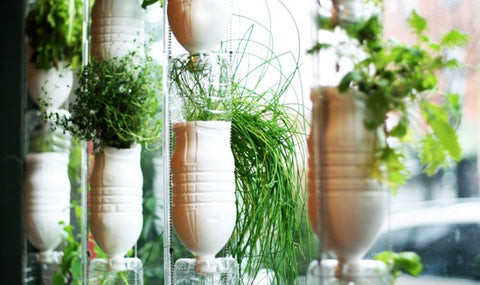Ew, I Found Mold On My Seeds And Aerogarden Sponges! What Does This Mean?
We get it; the presence of white fuzzy stuff growing in your pots or hydroponic system is rarely a pleasant surprise for gardeners and plant owners. But before you go throwing everything out and starting over, you might be surprised to learn that "fuzzy stuff" could actually be beneficial!
Although often disconcerting at first sight, mold in hydroponic systems such as AeroGardens can offer some surprising benefits to your plant’s health and may not actually be as harmful as it might seem at first.
Mold has been known to occur on AeroGarden compatible grow sponges (most common), and occasionally in our own Bottle Garden kits, which use a similar type of grow sponge. What all of these products have in common is that they all include some sort of growing medium (or “Smart Soil”) that is used for germinating seeds.
This growing medium is made from materials that include coco coir, peat moss and sometimes composted fir bark. Often the same habitats suitable for plant growth are also suitable for fungus and algal growth, and this is just a part of nature.
What Exactly Is the Mold You Find in Pots?
The term "mold" is used to refer to many different species of microbial fungi. Species often look fuzzy and can be white, black, orange, green or purple in color. Molds exists everywhere – indoors and out – and whether you realize it or not you are encountering many type of mold every single day of your life.
One of the most common types of mold that you are most likely to encounter on (or in) indoor gardening products or hydroponic systems like your AeroGarden is called Trichoderma.
Trichoderma can actually be highly beneficial to your garden and potted (or hydroponically grown) plants. It's presence can actually supress the growth of other fungi such as Pythium, Fusarium, and Rhizoctonia, which cause damping off and many other harmful plant diseases. Trichoderma is actually used as a beneficial soil inoculant (that means you can add it directly to your garden soil) where it colonizes on plant roots and improves the rhizosphere - the area around roots - to improve uptake of water and nutrients.
That said, we understand that mold growing on your sponges or potting soil may still be a cause for concern. And there are, of course, harmful types of mildew, molds, and other fungi that can damage or even kill your plants.
How Can You Prevent Mold?
Understanding how to prevent mold on your AeroGarden sponges is as simple as understanding what mold needs to grow and thrive. Mold, in general, tends to thrive in environments that are damp and warm; including packages of hydroponic grow sponges that are shipped during summer months in closed containers (i.e. our products, and all other AeroGarden compatible grow sponges).
If you want to prevent the mold in your AeroGarden, then you have to reduce temperatures and moisture levels, or both. Prior to packaging, we air-dry our plugs on large racks in order to reduce the chances of a Trichoderma bloom (not because it’s bad, but because it tends to induce a 1-star review regardless of the benefits!), and if you don’t like the look of it we recommend you store your sponges in a cool dry place. (Avoid storing your plugs in a plastic bag, keep them in a paper bag instead).
How Can You Start With Mold Removal In Your Hydroponic System?
Simply scraping away the white fuzzy mold from the surface of your growing sponges is all you really need to do. You can use a q-tip or small spoon. Regularly cleaning your hydroponic growing unit per the manufacturer's instructions is also key to a healthy harvest.
Is Putting Hydrogen Peroxide On Your AeroGarden Sponges Safe?
Some retailers and distributors of similar products treat their products with hydrogen peroxide. Technically putting diluted hydrogen peroxide on your AeroGarden sponges is safe, and it is effective at killing fungi such as mold (both good and bad), as well as reducing the chances of algae blooming (although this is more related to keeping your AeroGarden clean in general).
Hydrogen peroxide is cheap and readily available and can be applied with a spray gun or mister, just be sure to keep your hydrogen peroxide concentration below 4%. Typically what you buy online or at the store is a 3% concentration, which works just fine.

It’s Not Mold, It’s Algae On Your Coco Coir AeroGarden Sponges
What Is Algae & How Is It Different From Mold?
Algae is a group of photosynthetic organisms that are neither plant nor fungi. The majority of algae live in aquatic environments. The algae group contains seaweeds and many single-celled organisms. That's right, seaweed isn't actually a plant...it's a type of algae! Algae contain chlorophyll but lacks the true stems, roots, leaves, and vascular tissue we associate with plants.
Is Algae Bad for Plants or your AeroGarden Sponges?
Algae is normal and not usually harmful for most hydroponic systems, especially if it’s present in a low amount. Most of the time, you can wait until harvesting your crop before you treat your hydroponic system for algae growth, or you can also try the approach that we discuss below.
How Can You Prevent Algae In Coco Coir AeroGarden Sponges?
The same conditions that make our grow sponges a great place for seed germination and plant growth also make them a great environment for algae. Algae requires the same inputs that plants need to thrive, including
- light,
- water and
- nutrients
When all three are present, the environment is ripe for both plants and algae.
In order to prevent algae in your hydroponic grow sponges, we need to remove one of these three inputs. You can't really take the water out of a hydroponic growing system!
The approach we recommend to prevent algae in your AeroGarden or any other hydroponic system or growing media therefore, is to remove the light. NOT from the growing plants, but rather the water and growing media portion of your growing unit.
This can be achieved by placing some sort of light-shield around the base or stem of the plant – which could be as simple as a round piece of paper or piece of cardboard with a hole in the middle for the stem of the plant to grow through. The cardboard covers up the growing media blocking the light. This is a tried and true method for reducing unwanted growth, and one embraced by AeroGarden themselves, as you may have noticed the paper light covering on brand-name seed pod kits.
Regular cleaning of your hydroponic unit will also go a long way towards eliminating the chance of algal growth. This should be done in between harvesting and planting. Soap and warm water may be sufficient to clean your water reservoir, but if you have a particularly nasty algae infestation, you should also clean with isopropyl alcohol (just be sure to rinse it all out before starting up your garden again).
If you’re looking for a budget and eco-friendly replacement for your AeroGarden pods, try out our AeroGarden Compatible Grow Sponges which work quite well when paired with our dwarf seed varieties. And if all this mold-talk has got you second-guessing – don’t worry, we won’t leave your plants out to rot! We offer a Green Thumb Guarantee where you can always get a replacement or refund for your purchased product.












Since the growth of algae depends on light, water and nutrients, if I cut off the light completely, will algae stop growing completely.
Can I spray a 50/50 solution of water & Hydrogen peroxide on the grow sponge while a few cuttings are in the sponge pod to kill that green stuff’ stuff & not harm the cuttings?
I found your sponges on Amazon tonight doing research for an economical hydroponic system. In all the research I’ve done, I came across the question and answer segment of replacement sponges. I am so “blown away” with your knowledge and kindness in answering questions! I got to this link about mold/algae through the answers. Thank you for all the time and attention you give to everyone. I definitely appreciate it. Also, I was actually glad to know that your sponges are made of coconut coir. I have an entire vegetable garden on my balcony with coconut coir and I Love the stuff!